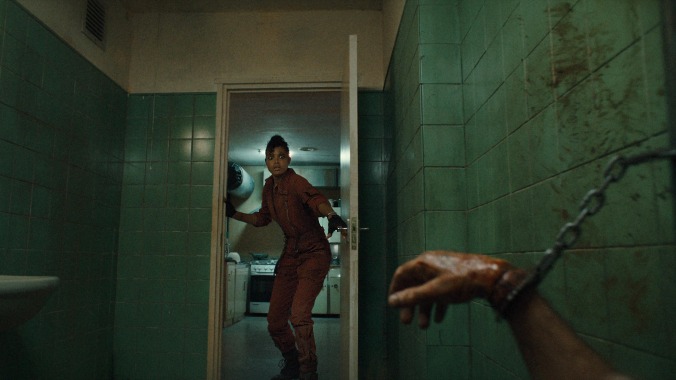Resident Evil fails to breathe new life into a franchise that won’t die
Netflix's small-screen adaptation of the iconic survival horror games lacks, well, horror
TV Reviews Resident Evil
You’d be forgiven for hearing there’s a new Resident Evil adaptation coming out and thinking, “Didn’t they just try that?” Over the past 20 years, there have been seven Resident Evil movies, including a reboot that came out less than eight months ago. Now, Netflix is tossing yet another title based on the iconic horror games into the mix.
The new series Resident Evil shifts its origins from the U.S. to New Raccoon City in South Africa. The events of the games are meant to be canon and Raccoon City Classic™ is long gone. The show focuses evenly on two timelines, which all shows must apparently do these days. In 2022, twin sisters Jade and Billie Wesker (Tamara Smart and Siena Agudong) move to New Raccoon City with their father, mainstay Resident Evil villain Albert Wesker (Lance Reddick, king of “vaguely threatening face of a shady syndicate” casting). New Raccoon City is a company town built by Umbrella Corporation, a suspicious pharmaceuticals giant with a laundry list of secrets, including the truth about, hey, whatever happened to old Raccoon City?
And then there’s the 2036 storyline, which follows an adult Jade (Ella Balinska) “14 years after the end,” something we learn thanks to an on-the-nose subtitle announcement. She lives in an isolated encampment in the middle of post-apocalyptic London, studying zombies (or “zeroes,” as they’re known here) for any sign that the T-virus that ended the world might be evolving. Save for a cool 300 million survivors, the rest of the Earth’s population has been transformed into shambling masses that check all the modern zombie boxes: wet snarling, sniffing the air for blood, chowing down on background actors—you get the idea.
Between the two periods, the pre-dystopia storyline has more drive. Agudong, Smart, and Reddick work well together as a nuanced family unit. Albert toils for a company that’s up to no good, sure, but he’s also fiercely protective of his children. It would be a stretch to call him a “good dad” (what’s up with him taking their blood samples once every two weeks, for example?), but Reddick’s charisma and warmth round out what could be a fairly thankless role. It’s a shame, then, that the story is packed with inorganic dialogue and a parade of pop culture references. Billie Eilish, Lululemon, and Elon Musk are all name-dropped in the first five minutes of the first episode, driving home that this is the new Resident Evil. This would be tolerable if the outside world had any bearing on how things run in New Raccoon City. Instead, it comes off as lazy window dressing that undercuts the disquieting isolation of the town. “We’re in South Africa and there are, like, three black people here,” Jade whispers to Billie on the drive in.
The 2036 plot doesn’t fare any better, aside from a couple of good mutant-bashing set pieces, including one with a kaiju-sized caterpillar that makes us wish for a version of this show that’s … weirder. Unfortunately, Resident Evil is happy to rest on zombie-apocalypse clichés as Jade’s encampment is breached and she’s forced to find safety. There’s a Mad Max-style scavenger stronghold surrounded by zombies, an amoral ferryman who trades goods for safe passage to Calais, and, of course, an arm of the new Umbrella Corp. hot on Jade’s heels, led by smiling Irish sociopath Richard Baxter (a very game Turlough Convery).
Resident Evil doesn’t veer all the way into mystery box territory but there are some interesting questions raised in its first four episodes. The T-virus is responsible for all the zombies, yes, but it also mutates most anything in its path. Are there humans out there who are even more mutated? The absence of a grown-up Billie in 2036 also sets alarm bells for the 2022 story, and it’s young Billie who has the most compelling throughline of the show so far. The show mercifully doesn’t lead us on for very long, confirming Billie is still kicking around somewhere in 2036. As far as what she’s up to, you’ll have to find out for yourself.
Ultimately though, after an okay opening episode, Resident Evil settles into an action-adventure slog rather than anything remotely new or scary. The complete absence of “horror” here is an egregious sin. We’re introduced to monsters in the dark and gory lab experiments gone wrong, but never once do they land as frightening. Rather, they come off like superficial obligations to the genre.
The Resident Evil video game series has successfully reinvented itself more than once, retaining the kind of claustrophobic terror that put the franchise on the map in the first place. There’s none of that in this new story, which could be mistaken for yet another Walking Dead spinoff if you swapped out every mention of Umbrella and the surname Wesker. The original 1996 game is credited for the reemergence of zombies as a major pop-cultural force, but that wore out its welcome again a decade ago. Netflix’s Resident Evil is proof it’s time to bury a pickaxe in the franchise.